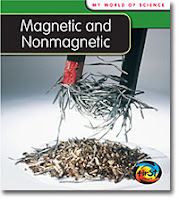Magnets are one of the ways children learn about force, motion and energy. Magnets are made of steel and have an invisible force that pulls other objects to or away from them. However, magnets will only attract or repel things made of iron or steel. A magnet's force can go through all liquids, all gases and some solids. Magnets have two ends, the South pole and the North pole. The opposite poles attract each other and the identical poles repel each other. The books and websites below detail the properties of magnets, relationship of magnets to other objects and offer a wealth of magnet experiments for your classes.
In Virginia, the Standards of Learning are found in Grade 2. This post is for working with second graders. The resources in this post are most appropriate for grades 1-2. (SOL and Background Info at end of post.)

Books
Experiments with Magnets and Metals (My Science Investigations) by Christine Taylor-Butler. 2012. 32p. Heinemann Library, (978-1-4329-5359-1). Gr. 1-2.
The book highlights the magnetism of the earth's core and how magnets attract and repel objects. It gives several detailed experiments that not only demonstrate the properties of magnets, but proper experiment procedures as well.

Magnetic and Nonmagnetic (My World of Science) by Angela Royston. 2003. 32 p. Heinemann Library, (978-1-4329-1469-1). Gr. 1-2.
This book is an overview of what magnets are and what can be done with a magnet. It is written in easy to read language with vivid pictures for children to understand the concepts of magnets.

Experiments: Magnets (Science Explorer) by Christine Taylor-Butler. Illus. by The Design Lab. 2009. 32p. Cherry Lake Publishing, (978-1-602-530-3). Gr. 1-2.
This book has excellent examples of experiments with magnets and magnetic fields. It is also a good overview of scientific methods and observations.
 The Science Book of Magnets by Neil Ardley. 1993. 29p. Gulliver Books, (0-15 -200581-1). Gr. 1-2.
The Science Book of Magnets by Neil Ardley. 1993. 29p. Gulliver Books, (0-15 -200581-1). Gr. 1-2. This book focuses on magnet experiments, including fishing with magnets, boat races with magnets and making your own magnet. It includes step by step illustrations of how to perform each experiment.
What Is Electricity and Magnetism?: Exploring Science with Hands-On Activities (In Touch with Basic Science) by Richard and Louise Spilbury. 2008. 32p. Enslow Elementary Publishers, (978-0-7660-3096-1). Gr. 1-2.
This book focuses on the definition of magnetism and how it relates to electromagnetism. It includes excellent photographs of experiments, with safety tips. It also shows students how to build an electromagnet.
Web Sites
Informational website for kids with multiple magnet experiments to discover.
This site has answers to commonly asked questions about magnets and magnetism.
Website with history of magnets, key information and fun facts about magnets.
Answers to many children's questions about magnets.
Website based upon children's drawings about magnets and fun facts.
Virginia Standards of Learning
2.2 The student will investigate and understand that natural and artificial magnets have certain characteristics and attract specific types of metals. Key concepts include:
a) magnetism, iron, magnetic/nonmagnetic, poles, attract/repel
a) magnetism, iron, magnetic/nonmagnetic, poles, attract/repel
Background Information from Curriculum Framework
- Magnets can attract objects made of iron, nickel, or cobalt. Magnets have a north and a south pole.
- Unlike magnetic poles attract and like poles repel. The north pole of one magnet attracts the south pole of a second magnet, while the north pole of one magnet repels the other magnet's north pole.
- A magnet creates an invisible area of magnetism all around it called a magnetic field.
- Magnets can attract objects made of iron, nickel, or cobalt.

No comments:
Post a Comment